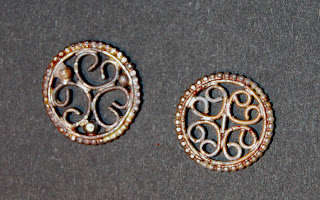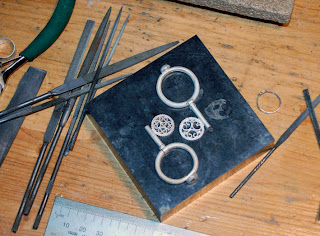While my husband is a master carpenter, I enjoy myself as a goldsmith interested in medieval jewellery. I still hope that one day he will make me a chest as large as the one he made for all his medieval tools so I can store my precious silver and gold handiwork. However, for the moment he deems my production not large enough. So I better get started about some of the things I made or am making at the moment.
For the medieval feast of Saint Nicolas on the 5th of December I got a very nice book written by Sandra Hindman, in which she describes her private collection of 35 golden rings dating from the 4th till the midst of the 16 century and compares them to rings found in several museum collections (S. Hindman. 2007. Towards an art history of medieval rings. Paul Holberton Publishing, London, UK. ISBN 978-1903470640. Medieval (gold) rings from a private collection placed in perspective.) Some of these rings are really fabulous and I really fell in love with them. The first one that I tried to replicate is a Byzantine Key ring dating from the 9th century and thought to originate from Constantinople (number 4 in the book). Where the original is made in gold, I made my two replicates in silver. One as original as possible, one with some small variations.
Roman Key ring from the 2nd Century AD,
photographed from two sides (Collection MAK Köln; Schmuck II, 1985)
Left: Byzantine key ring, 11-12th Century AD; Right: Roman key ring, 2-4th Century AD
(Collection MAK Köln; Schmuck II, 1985)
In the 6th century BC, lock and key were invented by the Greek sculptor and architect Theodorus of Samos (or so Pliny tells us). In Roman times many of the keys could in principle be worn as rings, where shank and bit were solidly connected to the bow that would fit around the finger. But of course they could also be attached to a belt or stored otherwise. Most of these rings were made in base metals and quite a large number of key rings from Roman times and later have been found.
Byzantine Key Ring in gold, 9th Century (Hindman, 2007, ring no4)
The described ring is composed of a rounded band that is thicker on one side than the other. A round heart-shaped pierced disk is fitted to an in this case rotating shaft while on the opposite side of the ring a small round bezel with faded inscription is shouldered to the hoop. The ornate disk suggests it may have come from another piece of jewelry and thus that this particular ring probably never functioned as an actual key.
My two rosettes just soldered together, still red of the borax.
Making my replicates I started with the ornamental disk or rosette, which has an outer diameter of approximately 14 mm. I first made a smooth ring of approximately 12 mm in diameter out of a flattened strip of thread, approximately 1 mm in width and 0.5 mm thick. The heart (or horse shoe if you prefer that) shaped ornaments and the small strip inside the rosette I made from the same material, fitting them carefully together and soldering them in place. Around the filled circular ornament the original has 23 round granules, instead of soldering small granules one by one, I used 1 mm diameter silver "pearl-thread'", meaning my ring has some 36-37 small globules around the rosette.
The two connected shanks with both rosettes, the bottom
one the replicate one the top one my own variation.
Shank and bit together.
The two shanks I made of 2 x 15 mm silver tube with a diameter of 3 mm. To start with I left the two shanks connected and only separated them after soldering the rosettes. On each side they were ornamented/thickened with a piece of approximately 2 mm silver tube with 4 mm diameter, neatly fitting and soldered in place. A 3 mm piece of silver tube with 3 mm diameter was later soldered on top of each shank as eye to be later connected to the ring.
Ring and bezel.
For the ring itself I started with a piece of 3 mm solid silver thread. Hammering both ends until they reached a thickness of about 2 mm diameter at the ends and a length of approximately 6.7 cm (large enough my middle or index finger), annealing the piece regularly. Rounding the ring on a tribulet, sawing the ends straight, filling and solderingit close. This resulted nicely in slightly oval rings like in the original. Some leftover silver was smelted to yield a drop of silver of approximately 6 mm diameter and soldered to the thinner part of the ring to form the bezel.
Just soldered the shanks to the rings, will they hold?
Yes they hold!
In the thicker part of the ring, I now filed a slot where the shank would fit. I heated the whole ring to oxidize the outer layer. For a normal soldering you want your parts to be nicely clean to solder together. In this case I just wanted the opened eyelet of the shank to solder close without getting stuck to the ring which would also heat up while reaching soldering temperatures. This worked nicely and shank and ring can move nicely in all directions as they should! So now they only need to be filed and sanded where necessary and to be polished to give a nice shine.
My silver replicate of the 9th Century Byzantine Key Ring.
My silver variation on the 9th Century Byzantine Key Ring.
As said before, I made two rings. One is identical to the original as it has 4 heart shapes in its rosette. The other I varied slightly and is decorated instead with three hearts and three small silver globules. I have been wearing one in the weekend we spend in castle Loevestein in March and must say that they wear quite well as the shank and bow-ring are not fixed but can move nicely.



















